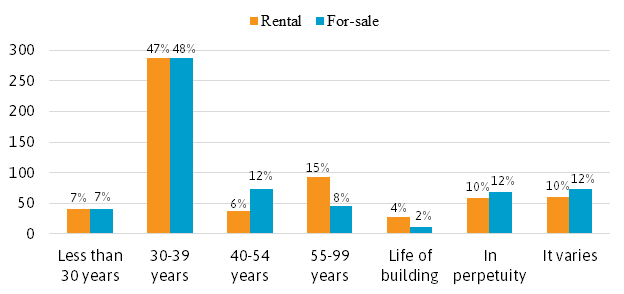In rising housing markets, it would do little good to require affordable homes or apartments without providing a mechanism to ensure that the units remain affordable over time.
If inclusionary programs are to create and preserve mixed-income communities, long-term restrictions are vital for the program to have a lasting impact. After all, if homes expire out of the program and return to market rate after a few decades, the program won’t actually increase the stock of affordable housing.
The overwhelming trend has been for inclusionary housing programs to adopt very long-term affordability periods. The vast majority of programs have affordability requirements that last for 30 years or longer; only 7% require units to remain affordable for less than 30 years. Many programs have functionally permanent affordability; units must remain affordable in perpetuity, for 99 years, for the life of the building.*
Even programs with 30-year affordability restrictions aim to preserve affordability in perpetuity by “resetting the clock” on each transaction and by maintaining the preemptive option to purchase the unit back upon transfer.
Program Distribution by Affordability Term and Tenure

Source: Wang and Balachandran (2021)
It is not entirely clear who benefits from shorter-term restrictions. For homeownership projects, a developer forced to sell units with 15-year restrictions faces roughly the same economic cost as selling units with 99-year restrictions.
For rental properties, the economics are a bit more complex. An investor might pay more for a property with rent restrictions that expire after 15 years than one with a 99-year restrictions, but the difference might be slight. In other words, the length of affordability makes a big difference to the long-term impact of the program, but only a small difference on the front end.
Montgomery County, Maryland
Montgomery County extended their affordability periods after experiencing a loss of previously built inclusionary housing units. Of the 14,000 inclusionary homes that have been built in Montgomery County over the past 40 years, approximately 9,400 have reverted to market rates due to expiring control periods.
At the program’s outset the affordability term was only five years. In 1981, the affordability period was increased to 10 years. It was not until the mid-2000s that county officials took more aggressive steps to preserve its inclusionary housing units, increasing affordability periods to their current level: 99 years for rental housing and 30 years for ownership units. In addition, the county now records a new 30-year restriction each time an ownership unit is sold, which should result in most of these homes remaining affordable indefinitely.
Chicago, Illinois
Chicago initially allowed inclusionary homeowners to sell units on the open market after five years, resulting in the loss of many of the first homeownership units built through the city’s inclusionary housing program. To prevent future losses, the city created the quasi-public Chicago Community Land Trust (CLT) in 2006 to improve the stewardship of affordable homeownership units, prevent foreclosure, and retain units’ affordability in perpetuity. Generally, all new for-sale inclusionary homes must be placed in the CLT, which requires homeowners to agree to a 99-year deed restriction.
Stamford, Connecticut
Stamford adopted its program in 2003 when the city had just prepared an analysis projecting a shortage of 8,000 affordable housing units in the city. It was determined that, as a relatively small city, Stamford would need every single affordable unit to last. As the city’s program director said “If we allowed these units to expire after 30 years, which was the conventional HUD affordability term, we’d start losing units as fast as we produced them, and it would be a futile program.”
Cambridge, Massachusetts
Cambridge administrators were motivated by their recent experience with the expiration of the city’s federally-subsidized affordable housing units at a time when affordability needs were growing. Officials in Cambridge also reasoned that the affordability term should be permanent since the bonus density provided to the landowner as part of the inclusionary housing agreement would also be permanent.

Balancing Wealth Building and Affordability
Policymakers sometimes feel that they are forced to choose between preserving affordability and offering wealth-building opportunities to homeowners. However, research strongly suggests that well-designed inclusionary housing programs can achieve both goals. Continue reading

Mechanisms for Preserving Affordability
Deed restrictions, covenants or ground leases are generally used to ensure that restricted units remain affordable over the long term. Continue reading

The Need for Stewardship
While legal documents provide the basic framework for preserving long-term affordability, many communities have concluded that legal documents alone are insufficient. Continue reading


